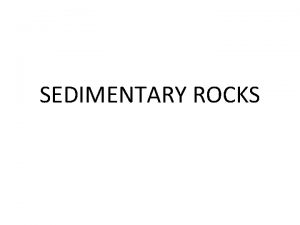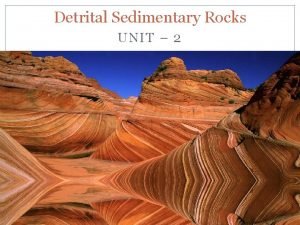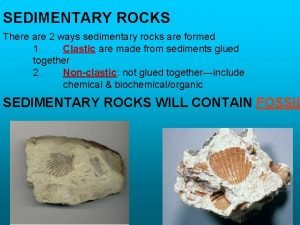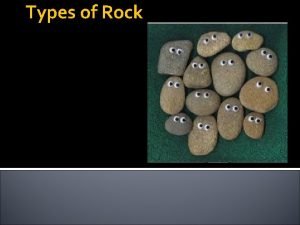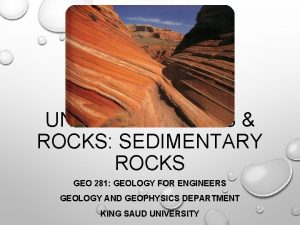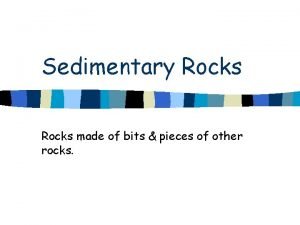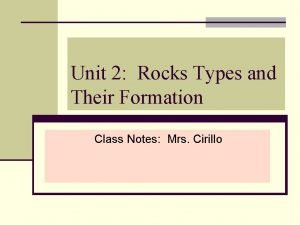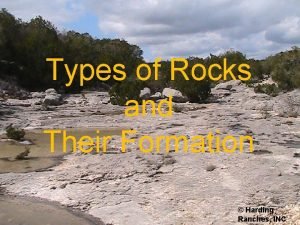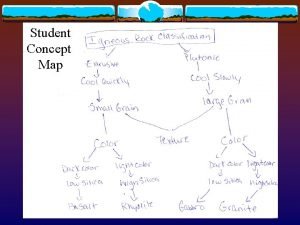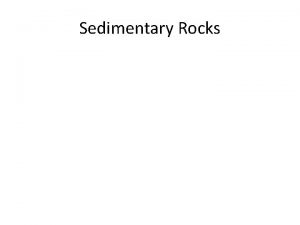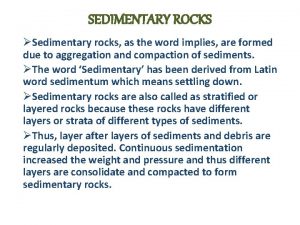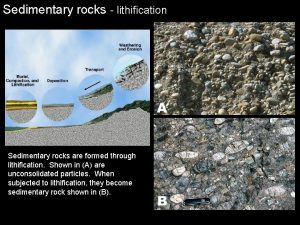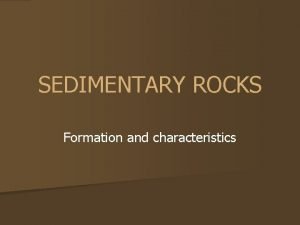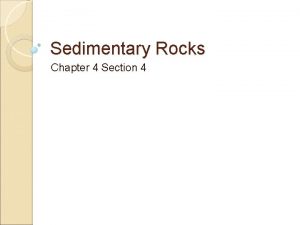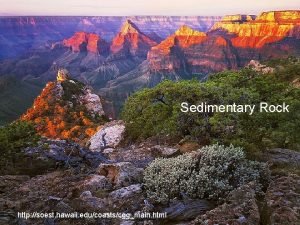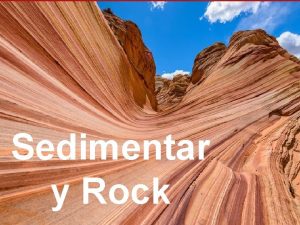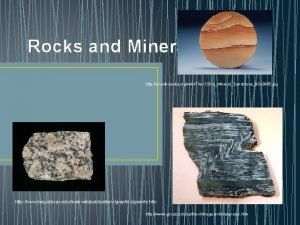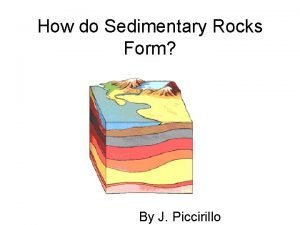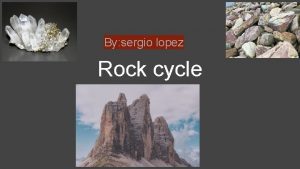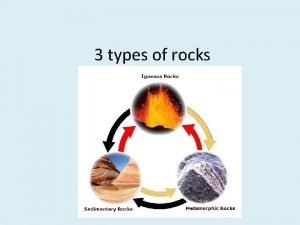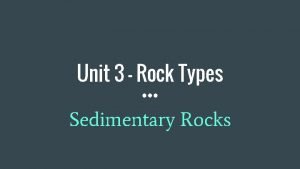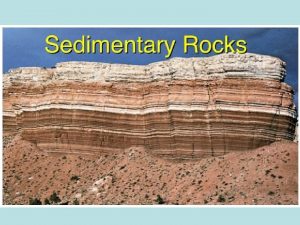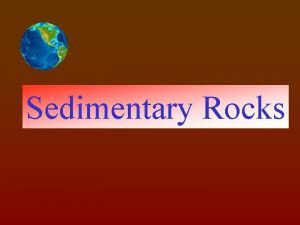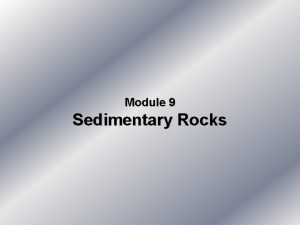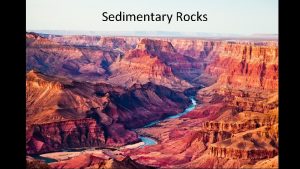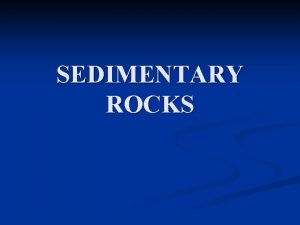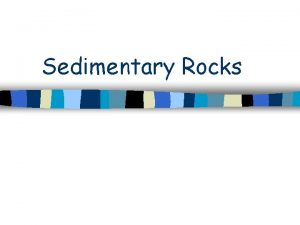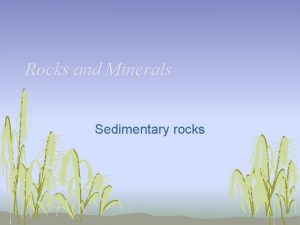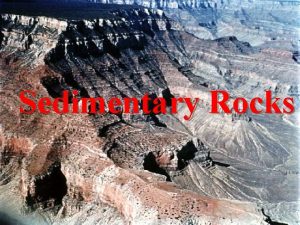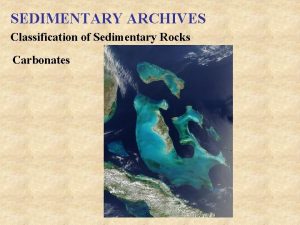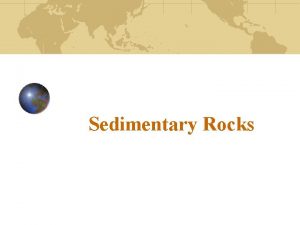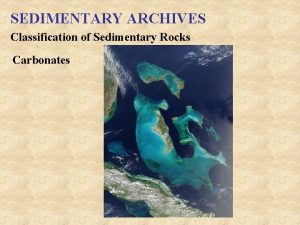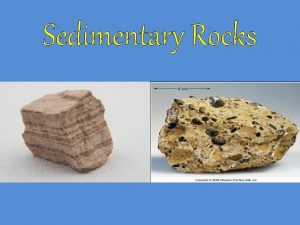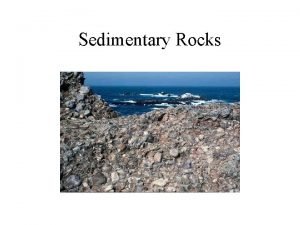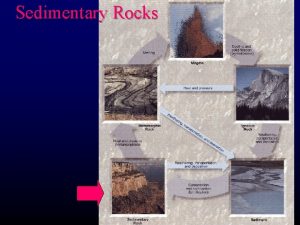SEDIMENTARY ROCKS SEDIMENTARY ROCKS Introduction Detrital Rocks Chemical







































- Slides: 39

SEDIMENTARY ROCKS


SEDIMENTARY ROCKS • • Introduction Detrital Rocks Chemical and Biochemical Rocks Lithification

Sedimentary Rocks Introduction

Introduction • Sedimentary rocks only form at the Earth’s surface. • Weathering: breakdown of pre-existing rock – Physical or chemical breakdown • Erosion: transport of sediment on Earth’s surface

PSCI 131: Sedimentary Rocks - Lithification • “Lith” = stone • How sediment becomes rock • Two types of Sedimentary Rock: – Detrital (Clastic) – Chemical

Mechanical weathering Chemical weathering Gravel, sand, silt, clay-sized particles Clay minerals and ions, compounds in solution Transport Deposition (Detrital sediments) Precipitation OR Used by from solution organisms Lithification Deposition Detrital (Clastic) Sedimentary Rock (Ex. Sandstone) Lithification Chemical Sedimentary Rock (Ex. Limestone)

Sedimentary Rocks Detrital Rocks

PSCI 131: Sedimentary Rocks Detrital Rocks • “Detrital” from “detritus” which means debris • Composed of solid sediment grains; distinguished by size of grains • All detrital rocks have a clastic texture Detrital rock with smaller grains Detrital rock with large grains

Transport of Sediments Bed load – coarse material, gravel and sand in the stream bed Suspended load – Fine material silt and clay up in the water column Dissolved load – free ions in solution

Classification of Detrital/Clastic Sediments Rounding: tells us about distance of transport More rounded = farther it has traveled Sorting: tells us about distance of transport and velocity of transporting agent Well sorted = farther it has traveled. Large size particles travel via stronger river current/glaciers



Depositional Environments – Where sediments come to rest

PSCI 131: Sedimentary Rocks - Lithification Processes • Compaction • Cementation

PSCI 131: Sedimentary Rocks - Lithification • Begins with deposition & burial of sediment under more sediment

PSCI 131: Sedimentary Rocks - Lithification Compaction • Decreases porosity (empty space) • Drives out water • Can make flat grains stick together

PSCI 131: Sedimentary Rocks - Lithification Cementation • New crystals form between grains • Precipitation out of groundwater • Fills in remaining porosity Original sand grain From: northstonematerials. com Cement crystals From: unibe. ch

Examples of Detrital Sedimentary Rocks

PSCI 131: Sedimentary Rocks - Detrital Shale • Most abundant sedimentary rock – 2/3 of all sedimentary rock is shale • Made of clay grains – Microscopic sheets – From chemical weathering of feldspar

PSCI 131: Sedimentary Rocks - Detrital Shale Scanning electron microscope image of shale showing flat clay grains. Scale bar is 0. 005 cm. http: //geology. com/rocks/shale. shtm

PSCI 131: Sedimentary Rocks - Detrital Sandstone • Cemented sand-size grains • Sand: 1/16 mm – 2 mm diameter – Quartz is predominant mineral

PSCI 131: Sedimentary Rocks - Detrital CONGLOMERATE/BRECCIA • Cemented gravel-size grains • Gravel: greater than 2 mm CONGLOMERATE has rounded gravel BRECCIA has angular gravel

Examples of Chemical and Biochemical Sedimentary Rocks

Mechanical weathering Gravel, sand, silt, clay-sized particles Transport Deposition (Detrital sediments) Lithification Detrital (Clastic) Sedimentary Rock (Ex. Sandstone) Chemical weathering Clay minerals and ions, compounds in solution Transport Precipitation OR Used by from solution organisms Deposition Lithification Chemical/Biochemical Sedimentary Rock (Ex. Limestone)

Precipitation – Chemical Sedimentary Rocks • Precipitation: dissolved minerals can precipitate out of mineral rich solutions as water evaporates and/or more mineral material is added https: //www. nps. gov/media/photo/gallery. htm? id=F 3 AECF 9 F-155 D-4519 -3 EAABFC 85829 E 3 CB

Biochemical Sedimentary Rocks • Organisms in the ocean utilize the dissolved ions to produce shells/skeletons. – Made out of Ca. CO 3 • These shells/skeletons get lithified into a sedimentary rock. – Similar to how gravel/sand/clay are lithified (clastic texture) By Sannse at English Wikipedia. CC BY-SA 3. 0, https: //commons. wikimedia. org/w/index. php? curid=2 615185

PSCI 131: Sedimentary Rocks – Chemical rocks Chemical Rocks: Crystalline limestone - Nonclastic texture - Interlocking calcite crystals - Precipitated from seawater

PSCI 131: Sedimentary Rocks – Chemical rocks Chemical Rocks: Microcrystalline limestone - Nonclastic texture - Interlocking microscopic calcite crystals - Precipitated from seawater

PSCI 131: Sedimentary Rocks-Other biochemical rocks Chert and Flint • Composed mainly of microcrystalline quartz (Si. O 2) • Nonclastic texture • Can be chemical or biochemical – Biochemical – marine skeletons composed of Si. O 2 are completely dissolved in water • Very hard FLINT CHERT

PSCI 131: Sedimentary Rocks – Chemical rocks Chemical Rocks: Travertine - Nonclastic texture - Porous - Precipitated from groundwater in caves

PSCI 131: Sedimentary Rocks – Other chemical rocks Other chemical sedimentary rocks • Rock gypsum and rock salt – Nonclastic texture – Interlocking mineral crystals – Evaporation of salt water – “Evaporites” Bonneville Salt Flats, the ancient floor of Lake Bonneville, now mostly evaporated

PSCI 131: Sedimentary Rocks – Biochemical rocks: Coquina - Clastic texture - Shell fragments & cement - Fragile - Shorelines

PSCI 131: Sedimentary Rocks – Biochemical rocks: Fossiliferous limestone - Clastic texture - Shell fragments, whole shells, mud matrix, & cement - Hard - Shallow ocean

PSCI 131: Sedimentary Rocks – Biochemical rocks: Chalk - Clastic texture - Microscopic shells (plankton) - Very soft - Deep ocean

Types of Sedimentary Rocks • Detrital/Clastic – traveled, lithified, contains clasts – Ex. Sandstone, Conglomerate, Breccia, Coquina (bioclastic) • Chemical – precipitated directly by water – Ex. Limestone, Dolostone, Rock Salt • Microcrystalline – very tiny crystals (can’t be seen) – Ex. Chert (contains quartz, also has conchoidal fracture) • Biochemical – precipitated directly by organisms (usually Ca. CO 3) – Ex. Fossiliferous limestone • Organic – rocks that consist mostly of carbon – Ex. Coal

Coal Approx. 300 million years ago, there was many swampy forests on Earth. Plants died and littered the swamp floor. When the surface conditions changed, water and dirt washed in and stopped the decay process. Over time, many layers had formed, the weight pushed down on each layer. Heat and pressure produced chemical and physical changes in the plant layers which forced out the oxygen and left carbon-rich deposits which became peat and then coal.

Oil and Natural Gas When organic-rich rock (usually shale) is buried, it is subjected to increasing temps and pressures. At about 60°C, oil begins to form due to cracking of the organic matter. Oil window – 60 -120°C Gas window – 100 -200°C After separation from source rock, the oil/gas (lighter than water) migrate upward through permeable rocks or fractures until they are either stopped by a tight, non-permeable layer or seep through the surface.

End of Sedimentary Rocks
 Clastic chemical and biochemical sedimentary rocks
Clastic chemical and biochemical sedimentary rocks Detrital sedimentary rocks
Detrital sedimentary rocks Igneous rocks metamorphic rocks and sedimentary rocks
Igneous rocks metamorphic rocks and sedimentary rocks Igneous metamorphic and sedimentary
Igneous metamorphic and sedimentary Clastic sedimentary rocks examples
Clastic sedimentary rocks examples Chemical sedimentary rocks definition
Chemical sedimentary rocks definition Detrital
Detrital Mun earth science
Mun earth science How do chemical sedimentary rocks form
How do chemical sedimentary rocks form Erosion sedimentary rocks
Erosion sedimentary rocks Esrt sedimentary rocks
Esrt sedimentary rocks Rock identification
Rock identification Igneous rock concept map
Igneous rock concept map Rocks formation
Rocks formation Sedimentary
Sedimentary Characteristics of sedimentary rocks
Characteristics of sedimentary rocks Graded bedding
Graded bedding In sedimentary rocks lithification includes
In sedimentary rocks lithification includes Sedimentary rocks characteristics
Sedimentary rocks characteristics Cementation sedimentary rocks
Cementation sedimentary rocks Sorting sedimentary rocks
Sorting sedimentary rocks Chapter 4 section 3 sedimentary rock answer key
Chapter 4 section 3 sedimentary rock answer key Where does coal form
Where does coal form Fun facts about sedimentary rocks
Fun facts about sedimentary rocks Esrt sedimentary rocks
Esrt sedimentary rocks Sedimentary rocks characteristics
Sedimentary rocks characteristics Classify sedimentary rocks
Classify sedimentary rocks Sedimentary rocks leaving cert
Sedimentary rocks leaving cert Esrt sedimentary rocks
Esrt sedimentary rocks Features of sedimentary rocks
Features of sedimentary rocks Characteristics of sedimentary rocks
Characteristics of sedimentary rocks Chapter 6 sedimentary and metamorphic rocks
Chapter 6 sedimentary and metamorphic rocks Facts on sedimentary rocks
Facts on sedimentary rocks 3 categories of rocks
3 categories of rocks Coral sedimentary rock
Coral sedimentary rock How do the rocks stick together to undergo lithification?
How do the rocks stick together to undergo lithification? Is coal clastic organic or chemical
Is coal clastic organic or chemical Sedimentary rocks transportation
Sedimentary rocks transportation Concept map of magma
Concept map of magma Q
Q
